Overview
This article delves into the essential options for small business loans in Australia, effectively highlighting the various types of loans available to entrepreneurs. Understanding these financial instruments is crucial; it includes:
- Secured loans
- Unsecured loans
- Lines of credit
- Government-backed loans
By grasping these options, small business owners can make informed decisions that align with their specific needs and goals. Are you aware of the financial tools that could propel your business forward? This knowledge not only empowers you but also positions your business for success.
Introduction
In the dynamic realm of small business financing in Australia, grasping the complexities of various loan options is crucial for entrepreneurs aiming to excel.
Consider secured loans, which utilize collateral to secure favorable terms, versus flexible unsecured loans that provide the freedom from asset requirements. Each financing avenue offers distinct advantages and challenges.
Furthermore, as small business owners navigate their financial paths, they should also explore alternative options such as:
- Lines of credit
- Government-backed loans
These options can deliver essential support during uncertain economic periods. With the right insights and guidance, entrepreneurs can make informed decisions that align with their objectives, ensuring they obtain the funding necessary to propel growth and success.
Understanding Small Business Loans in Australia
Small business loans in Australia serve as essential financial instruments that empower small enterprises to secure the necessary capital for a variety of needs, including startup costs, operational expenses, and growth initiatives. These loans are available in both secured and unsecured formats, with terms varying significantly based on the lender and the borrower’s financial profile. As we look ahead to 2025, the landscape for small enterprise financing is undergoing transformation, highlighted by investor loan commitments reaching 48,876—indicative of a strong appetite for funding opportunities.
For entrepreneurs, it is vital to comprehend the various loan types available, such as:
- Lines of credit
- Term loans
- Asset financing options like chattel mortgages
- Lease financing
This understanding is critical for selecting the financing that best aligns with their specific objectives and financial situations. Moreover, refinancing options are accessible, allowing business owners to adapt to their changing needs, whether they are operating a warehouse, retail space, factory, or hospitality establishment. By grasping these distinctions, entrepreneurs can make informed decisions that lay the groundwork for their success.
Finance Story, renowned for its professionalism and extensive expertise in the finance sector, is well-prepared to assist clients in navigating these options. This ensures they identify the most suitable financing solutions tailored to their unique circumstances. As noted by Amy Bradney-George, a former Senior Writer for Credit Cards at Finder, understanding the nuances of small business loans in Australia is essential for effectively maneuvering through the financial landscape. Furthermore, insights from the Business Credit Card Market Overview reveal that 97% of retail merchants accepted card payments in 2022, underscoring the critical nature of selecting the right financing solutions to optimize operations.
Secured Business Loans: Pros and Cons
Secured financing options, such as small business loans in Australia, are a popular choice for minor enterprises. These loans require borrowers to provide collateral—like property or equipment—which can lead to reduced interest rates and larger credit amounts. The benefits of small business loans in Australia include lower interest rates and extended repayment periods, making them particularly appealing for businesses with significant funding needs. However, notable drawbacks exist; the primary concern is the risk of losing collateral if repayment obligations are not fulfilled, posing a serious threat to minor enterprises.
Before pursuing small business loans in Australia, it is crucial for entrepreneurs to assess their ability to meet repayment obligations. Labor Senator Katy Gallagher emphasizes, 'We need to move beyond short-term solutions and establish frameworks that safeguard minor enterprises from exploitative lending.' This underscores the importance of understanding the implications of collateral on financial agreements in Australia, especially regarding small business loans, as investor commitments have shown fluctuations, with a 4.5% decline in December 2024 compared to the previous quarter, yet still reflecting a 13.2% increase year-over-year.
Finance Story is dedicated to creating refined and tailored financing proposals, providing access to a diverse portfolio of lenders that enable entrepreneurs to secure personalized funding options that align with their needs. We assist with various commercial properties, including warehouses, retail spaces, factories, and hospitality ventures. Navigating these complexities requires careful consideration and a thorough evaluation of the current lending landscape, including average interest rates for small business loans in Australia, which are expected to remain competitive in 2025.
By grasping the advantages and disadvantages of secured financing, Finance Story aids entrepreneurs in mitigating risks, ensuring they make informed decisions that align with their financial goals.
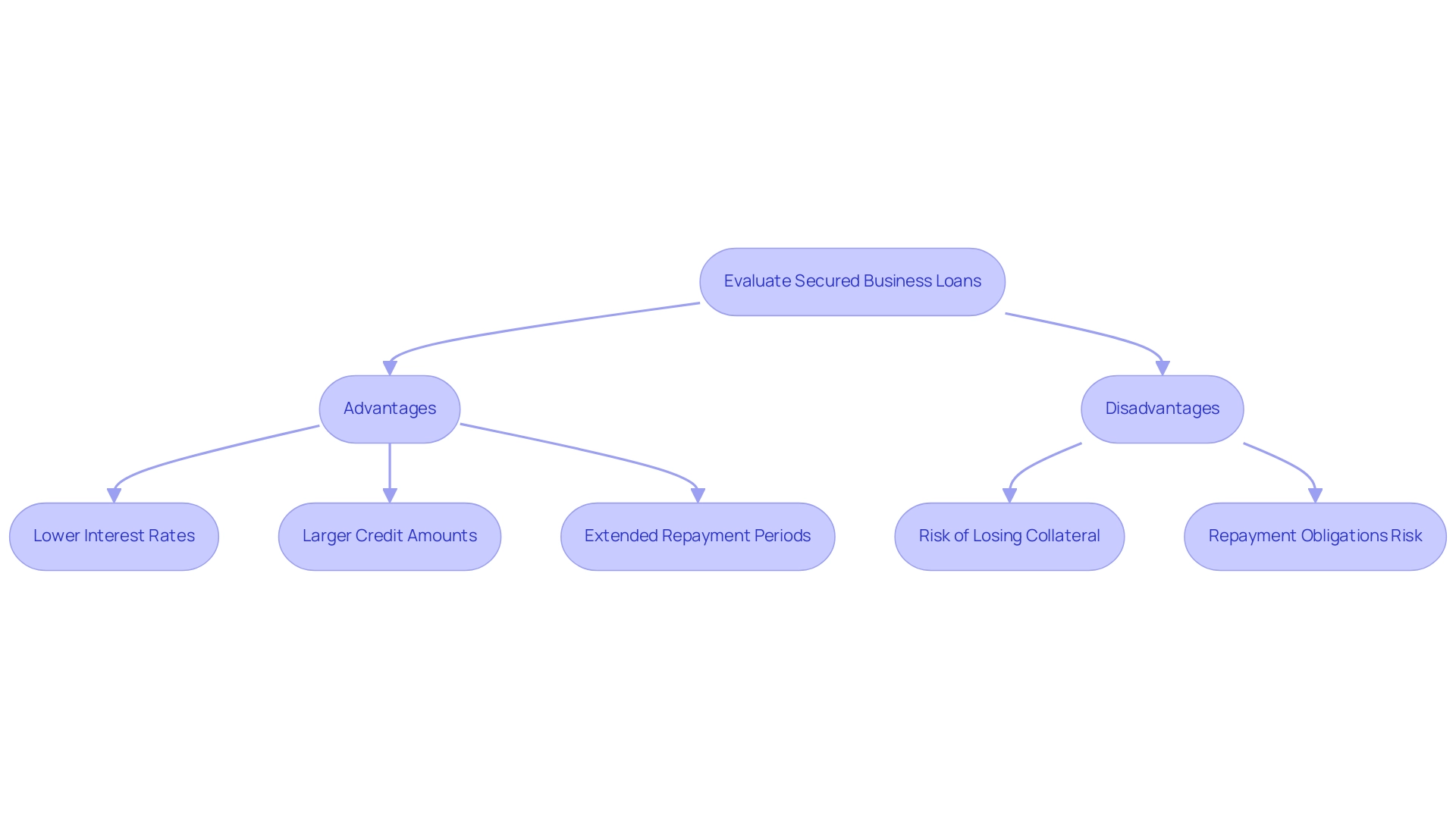
Unsecured Business Loans: Flexibility Without Collateral
Unsecured commercial financing presents a viable funding alternative for small enterprises, particularly through small business loans in Australia, primarily due to the absence of collateral requirements. This feature renders small business loans in Australia especially attractive to businesses that may lack substantial assets to pledge. Notably, the flexibility of small business loans in Australia allows enterprises to allocate funds for a variety of needs, ranging from operational costs to expansion initiatives.
However, it is essential to recognize that interest rates for unsecured credit are generally higher than those for secured alternatives, reflecting the increased risk assumed by lenders. Shane Duffy, founder and Funding Specialist Director at Finance Story, underscores the importance of understanding repayment criteria when considering financing options. With a BEng Hons in Manufacturing Engineering and a Diploma in Finance & Mortgage Broking, his extensive experience in enterprise growth and customized monetary solutions uniquely positions him to guide small business owners.
As he emphasizes, stakeholders must evaluate their financial situation and repayment capability before pursuing small business loans in Australia and unsecured funding, ensuring they select the appropriate financing option for their specific circumstances. Lenders typically seek clear evidence that the business can support its loan repayments, including sufficient profits to cover repayments even during off-peak seasons. A pertinent example is Finance Story's innovative lending process, which distinguishes itself through its commitment to accessing a diverse portfolio of private lenders and mainstream funding institutions, including small business loans in Australia.
This approach enables clients to secure tailored options, such as small business loans in Australia, that enhance their financial flexibility. Furthermore, statistics indicate that personal loan demand in Western Australia grew by 10% year-on-year in 2023, underscoring the increasing interest in various loan products. Additionally, with the next release of lending indicators scheduled for May 14, 2025, small business owners should remain informed about market conditions.
If you require guidance on navigating your financing options, please reach out to discuss your story and what you wish to achieve next.
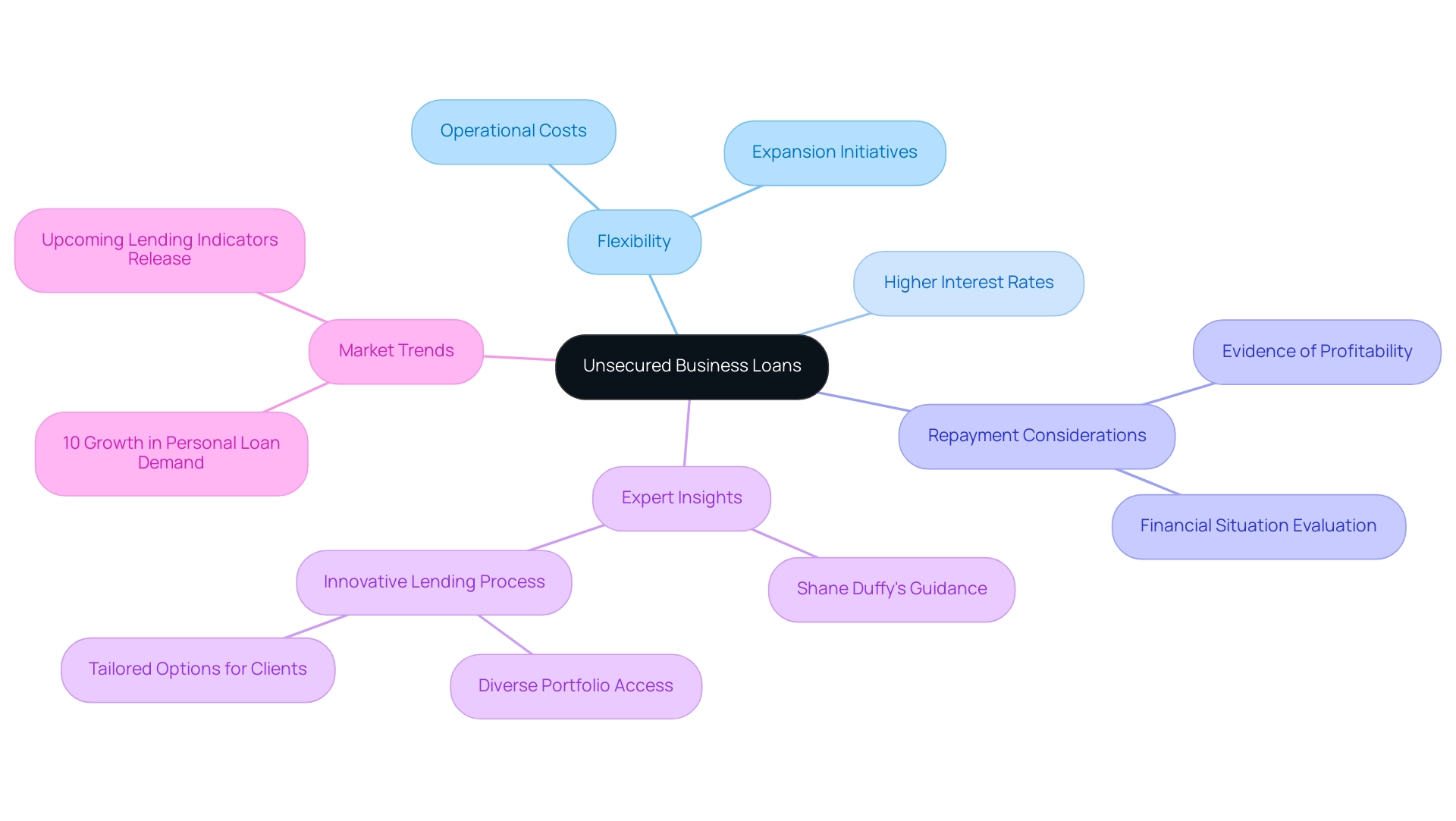
Lines of Credit: Managing Cash Flow Effectively
A line of credit serves as a vital financial resource for companies, granting access to a predetermined sum of funds that can be utilized as needed. This financial flexibility is particularly beneficial for managing cash flow gaps, addressing unexpected expenses, or seizing fleeting opportunities. In Australia, small business loans can be transformative for small businesses projected to navigate diverse economic conditions in 2025, as the ability to draw on funds when necessary is essential.
Notably, interest is charged only on the withdrawn amount, making lines of credit a cost-effective alternative compared to traditional borrowing. In December 2024, total new borrowing commitments for dwellings are anticipated to reach 132,082, reflecting a robust lending environment. Furthermore, average borrowing amounts for owner-occupier dwellings vary by state, with the highest average in NSW at $449,000 and the lowest in Tasmania at $383,000.
This context provides entrepreneurs with a comparative perspective of the market. Moreover, OnDeck offers a straightforward online application for small business loans up to $250,000, with funding accessible within one working day or as quickly as two hours. To navigate the complexities of securing the right financing for commercial property investments, it is crucial for owners to manage this credit wisely to avoid the pitfalls of mounting debt.
By closely monitoring cash flow and spending habits, you can ensure that the line of credit bolsters rather than undermines economic stability. Additionally, crafting a polished loan proposal is vital when approaching lenders, as it highlights your enterprise's viability and financial strategy. At Finance Story, we excel in developing tailored cases that cater to your specific needs, significantly enhancing your chances of securing financing.
With access to a diverse array of lenders—from high street banks to innovative private lending panels—we can assist you in financing various commercial properties, including warehouses, retail spaces, factories, and hospitality ventures. For customized funding strategies, schedule your free personalized 30-minute consultation with Shane Duffy, Head of Funding Solutions at Finance Story, and let us support you in crafting your next chapter.
Government-Backed Loans: Support for Small Businesses
Government-supported financing, including small business loans in Australia, is crucial for strengthening minor enterprises across the nation. By offering appealing conditions such as reduced interest rates and extended repayment durations, these loans present a viable option for startups and businesses facing economic challenges. In 2025, numerous government programs and grants will be available, serving as valuable complements to traditional financing strategies.
As Raja Abbas, a prominent Blog Editor, notes,
The majority of small businesses in Australia operate in the transport/warehousing industry, followed by retail and health care.
This insight underscores the diverse sectors that benefit from such monetary support. At Finance Story, we are dedicated to fostering strong, long-term relationships with our clients, ensuring they feel understood and supported in their financial decisions.
Our innovative lending process entails a comprehensive assessment of each client's unique circumstances, enabling us to tailor solutions that effectively navigate government-backed financing options. This approach, combined with access to a diverse portfolio of boutique lenders, private investors, and mainstream banks, empowers small enterprises to secure the necessary funding through small business loans in Australia. Moreover, with the average loan size for owner-occupier dwellings in Australia being $384,000 as of December 2024, understanding these government-backed options is essential for enhancing a company's growth trajectory.
Business owners must remain informed about the latest programs and opportunities available in the marketplace, thereby strengthening their case for diverse lending needs. As Natasha B. from VIC expressed, 'I will definitely be recommending your service to anyone.' We have alleviated the constant worry.
Once again, thank you for being a part of our journey. This testimonial reflects our commitment to providing bespoke mortgage services that assist clients throughout their financing journey.
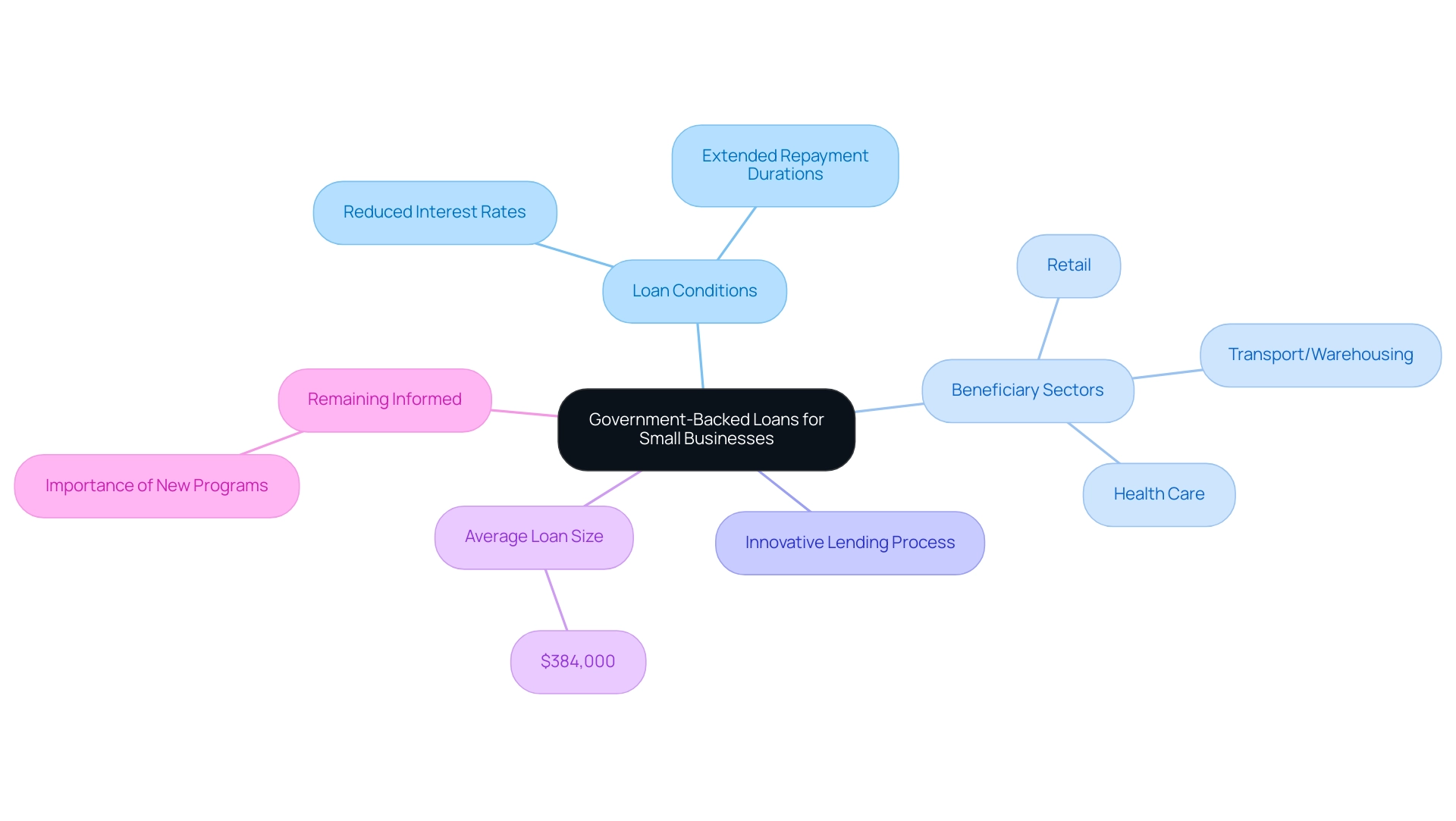
Navigating Interest Rates and Repayment Terms
Interest rates and repayment conditions are vital factors in determining the total expense of financing, making it essential for small enterprise owners to perform detailed comparisons among different lenders offering small business loans in Australia. Recent data reveals that the value of new loan commitments for commercial finance varies significantly, illustrating the dynamic nature of the lending landscape, with figures ranging from $5.39 billion to $22.22 billion. In 2025, Westpac offers an appealing Fixed Rate Unsecured Loan for enterprises, with amounts starting at $5,000 and reaching up to $250,000, alongside various repayment options designed to meet diverse needs.
Understanding the difference between fixed and variable interest rates is crucial, as it can significantly impact monetary obligations over time. Furthermore, being aware of the repayment schedule and any associated fees is paramount for effective budgeting and cash flow management. At Finance Story, our dedication to crafting refined and highly personalized business cases enables clients to feel acknowledged and supported in their financial decisions.
This understanding is critical when navigating the complexities of loan options, including financing for various commercial properties such as warehouses, retail premises, factories, and hospitality ventures. Our specialized expertise in assisting clients through challenging monetary situations, including refinancing options, provides valuable insights that lead to informed borrowing choices. Brad Buzzard, a senior money writer, emphasizes that a research-driven approach to analyzing these factors can yield clearer and more useful content for borrowers.
Ultimately, a comprehensive assessment of interest rates and repayment terms, combined with tailored small business loans in Australia, empowers entrepreneurs to make informed borrowing choices that align with their financial strategies.
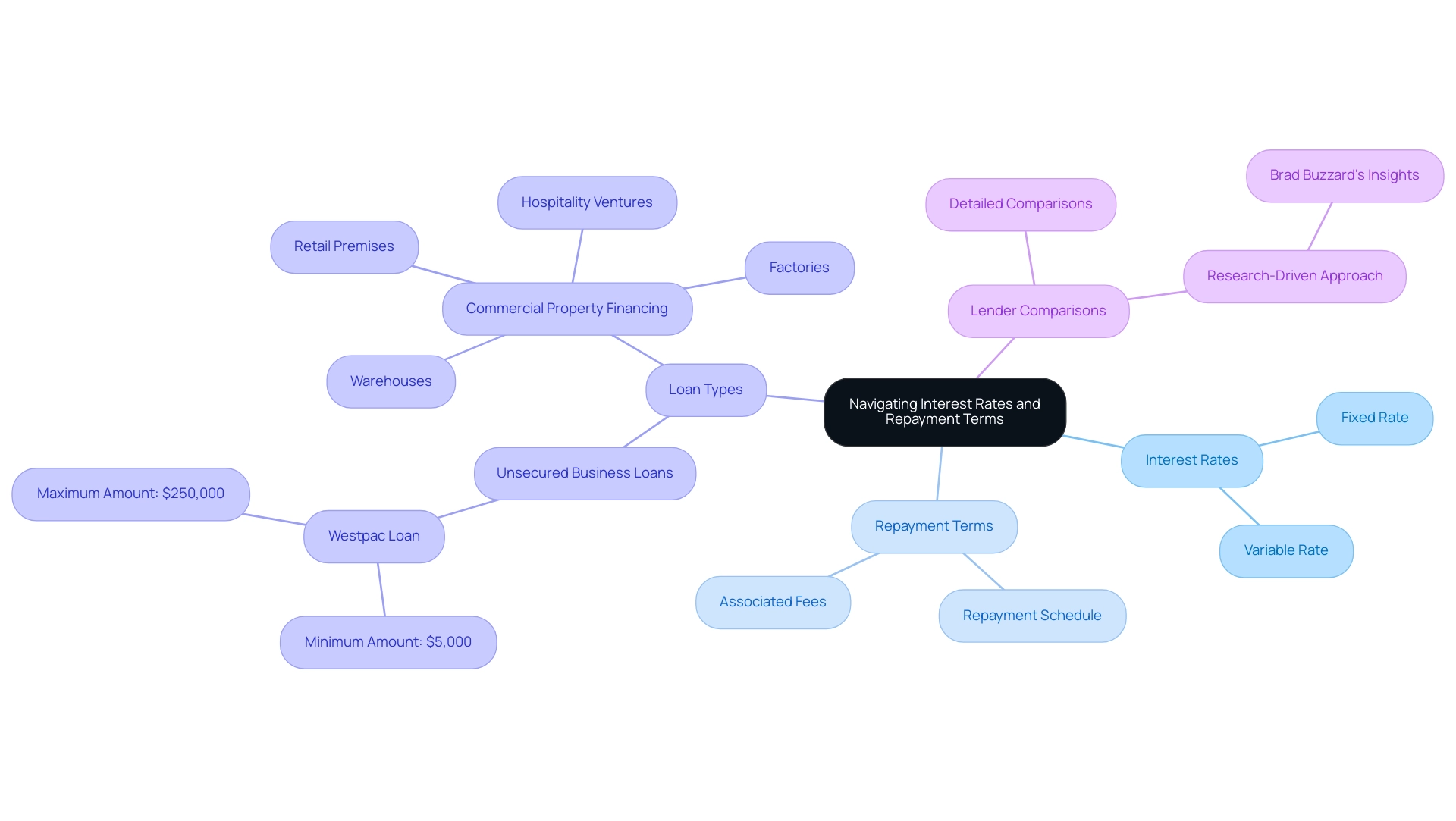
Exploring Alternative Financing Options
In 2025, alternative financing options are gaining traction among local businesses in Australia, with crowdfunding and peer-to-peer lending leading the charge. Crowdfunding allows entrepreneurs to gather small contributions from numerous individuals, often through online platforms, making it an accessible means to secure funds for various projects. Conversely, peer-to-peer lending forges direct connections between borrowers and investors, bypassing traditional financial institutions.
This innovation empowers entrepreneurs to access funds more swiftly and with fewer restrictions than standard loans. However, while these options present enticing opportunities, it is essential for owners to thoughtfully assess the potential implications and costs involved. As Sutton points out,
When you combine increasing demand for non-bank lending with the time constraints encountered by owners of medium enterprises, the role of the broker has never been more crucial.
Recent data indicates that approximately 10% of medium enterprises (SMEs) are uncertain about how to finance new investments, underscoring a significant opportunity for finance brokers, such as Finance Story, to guide them with tailored proposals and a range of financing solutions for commercial property investments. Finance Story collaborates with a comprehensive array of lenders, including high street banks and innovative private lending panels, ensuring owners have access to the right financing options. Notably, 92% of minor enterprises in Australia have a turnover of less than $2 million, highlighting the economic limitations many encounter and the importance of alternative funding options.
As the crowdfunding landscape continues to evolve, understanding its benefits and risks will be vital for entrepreneurs looking to leverage this funding method effectively. Furthermore, with small enterprises constituting 97.2% of all firms in Australia and facing high failure rates—60% of which collapse within the first three years—effective monetary management becomes crucial. Whether funding a warehouse, retail space, factory, or hospitality project, Finance Story’s expertise in crafting polished and highly individualized cases can enhance the success rates of these ventures, ensuring they secure the right financing tailored to their evolving needs, including refinancing options to adapt to changing circumstances.
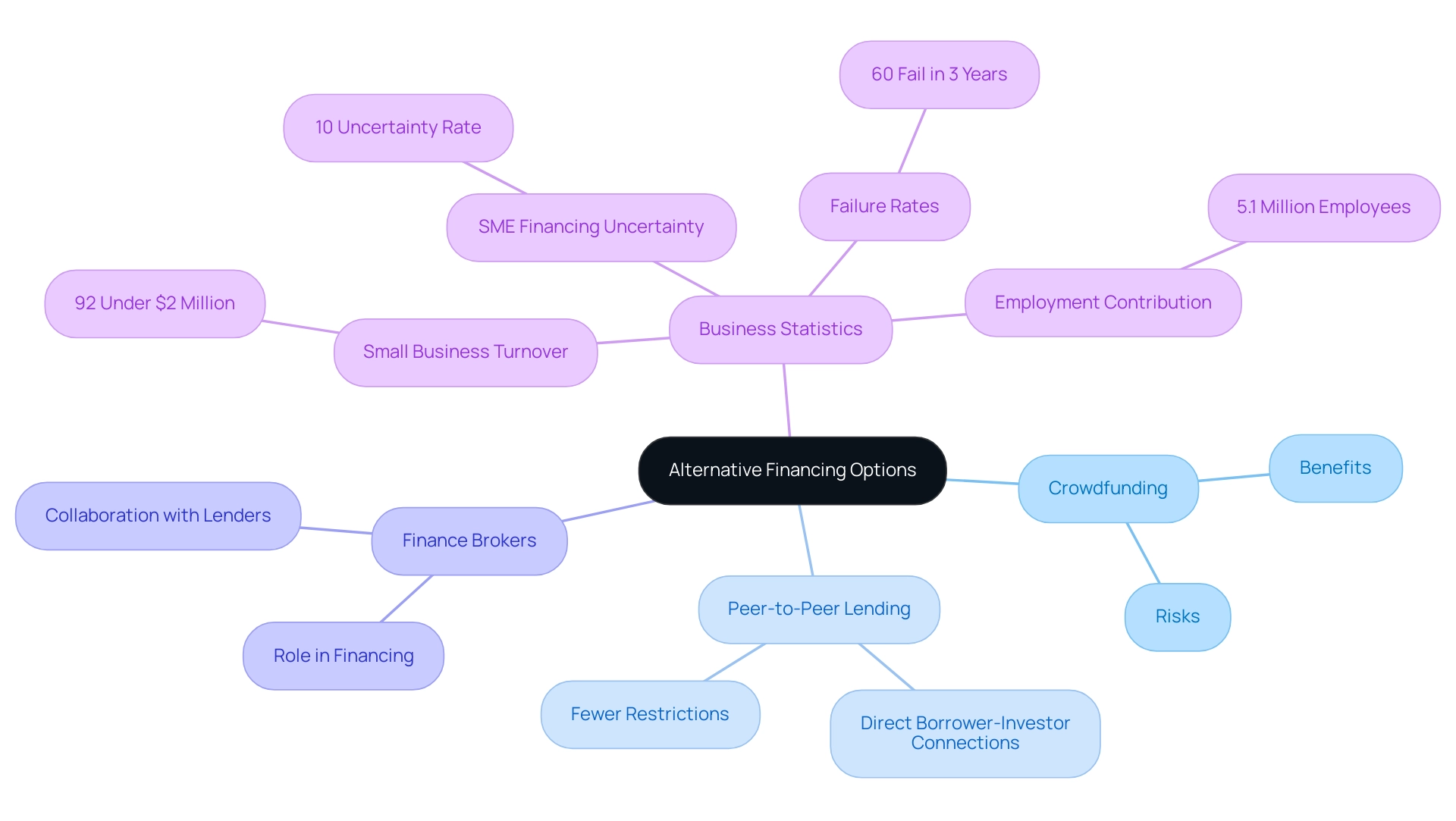
The Importance of a Strong Business Plan
Creating a solid plan is a crucial step in the small business loans Australia application process, serving as a blueprint that outlines the company's objectives, strategies, and projections. In 2025, lenders increasingly rely on these detailed plans to evaluate the viability of enterprises and their capacity to repay borrowed funds. A well-organized proposal that includes a detailed market analysis, operational strategies, and extensive projections can significantly increase the chances of securing small business loans Australia.
Sampson, a financial expert, emphasizes this point, stating,
Our plans are to be a very competitive player in the market in 2025.
Additionally, savvy investors are concentrating on firms leading in sustainable resources, making it crucial for entrepreneurs to highlight market trends in their plans. For instance, Finance Story's innovative lending process demonstrates how tailored small business loans Australia can significantly differentiate clients in a competitive landscape, allowing them access to a diverse portfolio of funding options from a full range of lenders, including high street banks and private lending panels.
This includes financing for various commercial properties such as warehouses, retail premises, factories, and hospitality ventures. Furthermore, refinancing options are available to assist companies in adapting to their evolving needs. By utilizing their knowledge in developing refined and customized proposals, Finance Story assists entrepreneurs in effectively presenting persuasive cases to lenders.
By dedicating time to create a thorough strategy, entrepreneurs can position themselves advantageously in a competitive financial environment, supported by Finance Story's professionalism and deep understanding of the finance sector to navigate the complexities of funding applications.
Overcoming Challenges in Securing Financing
For small enterprise owners, securing small business loans in Australia can often feel like navigating a complex maze, particularly in a competitive market. At Finance Story, we recognize the unique challenges you encounter, including:
- Limited credit history, which can impede access to financing
- Insufficient documentation that prolongs approval processes
- Fluctuating cash flows that may raise concerns for lenders
Our expertise in crafting customized financing proposals ensures that you present a compelling case to potential creditors, providing you with the best opportunity for success.
As Phil Collard, a lending expert at Money.com.au, notes, 'The right loan facility can be a very powerful tool to accelerate growth, so be sure to have your plans clearly mapped out, including expected ROI.' Furthermore, we collaborate with a diverse range of lenders, from high street banks to innovative private lending panels, tailored to your circumstances, whether you are financing a warehouse, retail premise, or hospitality venture. Testimonials from satisfied clients, such as Natasha B. from VIC, highlight our effectiveness: 'I will definitely be recommending your services to anyone.'
We have moved past the constant worry. Thank you for being a part of our journey. To successfully overcome funding obstacles, concentrate on preparing comprehensive documentation that showcases your economic health, maintain a robust credit profile, and partner with consultants at Finance Story, who can assist in identifying small business loans in Australia that are specifically designed to meet your needs.
Understanding the current landscape is crucial. The ASBFEO Small Business Pulse indicates shifting sentiments and operational challenges—such as the necessity for sole traders to manage multiple roles effectively to avoid burnout—vital for devising effective strategies to secure funding in 2025.

Choosing the Right Loan for Your Business Needs
Choosing the right financing option for your enterprise requires a comprehensive evaluation of your unique needs, financial situation, and future goals. As a small business owner, it’s crucial to explore the various small business loans available in Australia, along with their terms and conditions, to ensure they align with your operational strategies. Be aware that loans exceeding $150,000 may necessitate additional documentation, such as profit and loss statements and balance sheets, which can influence your decision-making process.
Engaging with a financial advisor can be invaluable in this journey, providing expert insights that clarify the lending landscape. Philana Kwan, Marketing Coordinator at Drive, states, 'Our extensive network of over 30 lenders empowers you to make informed comparisons, helping you discover the solution that aligns perfectly with your requirements.' Their guidance can ensure that the financing solution you choose, including small business loans in Australia, not only meets your immediate needs but also fosters sustainable growth and long-term success.
Finance Story exemplifies this approach through its innovative lending process, offering small business loans in Australia characterized by adaptability and access to a diverse portfolio of lenders, including mainstream banks, private lenders, boutique lenders, and angel investors. We collaborate closely with you in an ongoing relationship, providing continuous support and guidance throughout your loan journey to ensure that your financial strategies are tailored for growth. Additionally, we invite you to schedule your free personalized consultation with Shane Duffy, our Head of Funding Solutions, to discuss how our comprehensive lending solutions can help you achieve your business objectives.
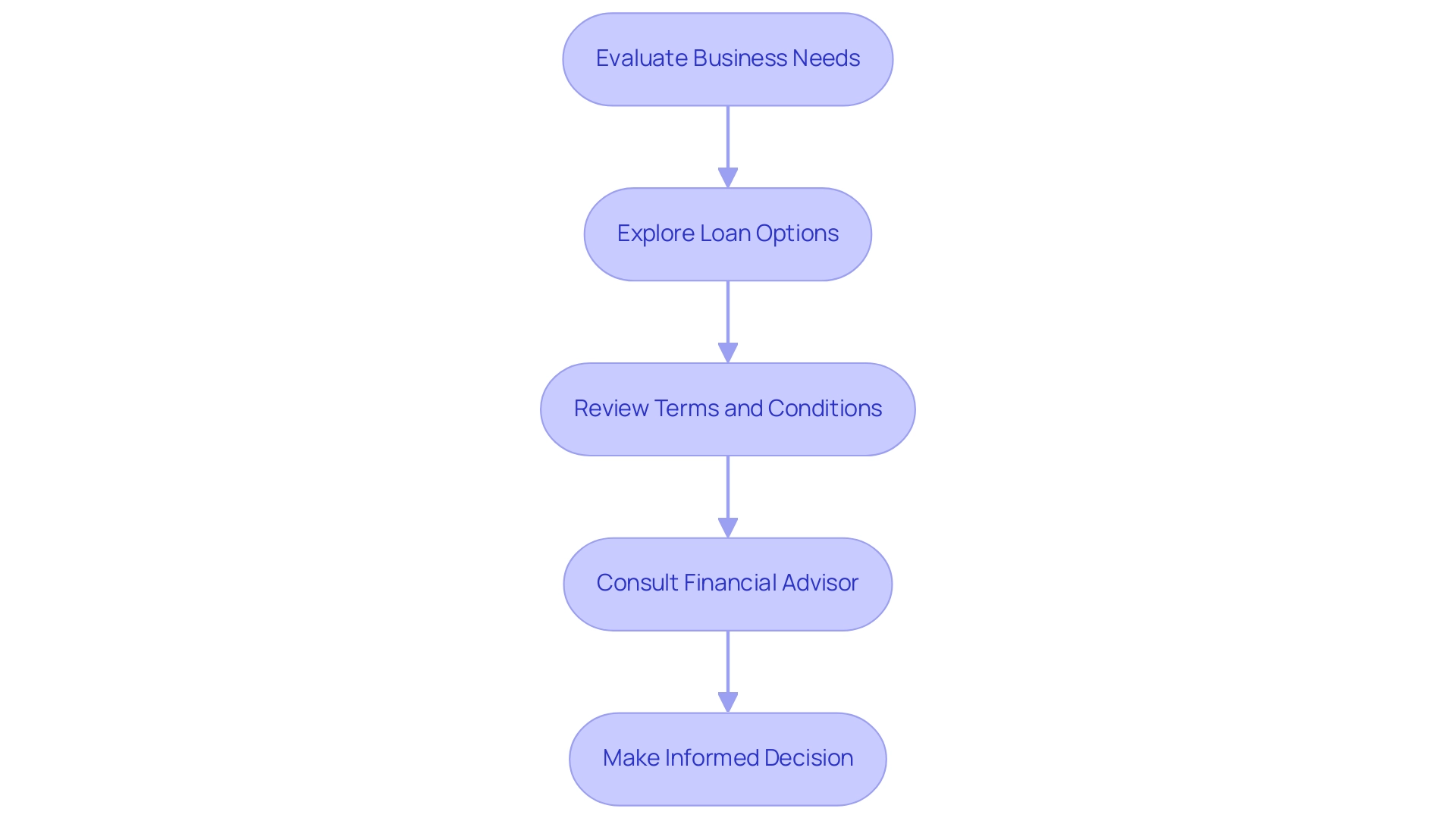
Conclusion
Understanding the diverse landscape of small business financing in Australia is essential for entrepreneurs seeking to secure the capital necessary for growth and stability. This article highlights various loan options, including secured and unsecured loans, lines of credit, and government-backed loans, each offering unique advantages and challenges. Entrepreneurs must assess their financial profiles and business needs to navigate these options effectively, ensuring they select the right financing solutions that align with their objectives.
Moreover, the importance of a strong business plan cannot be overstated. A well-structured plan enhances the likelihood of obtaining funding by clearly outlining business goals, strategies, and financial forecasts. As the financing landscape continues to evolve, it is crucial for small business owners to stay informed about market conditions and available funding opportunities. This proactive approach, combined with the guidance of financial experts, can significantly improve the chances of securing favorable loan terms.
Ultimately, the journey toward obtaining financing is complex but manageable with the right knowledge and support. By leveraging the insights provided and collaborating with experienced financial advisors, small business owners can navigate the lending landscape with confidence, ensuring they are well-equipped to meet their financing needs and drive their businesses toward success.




